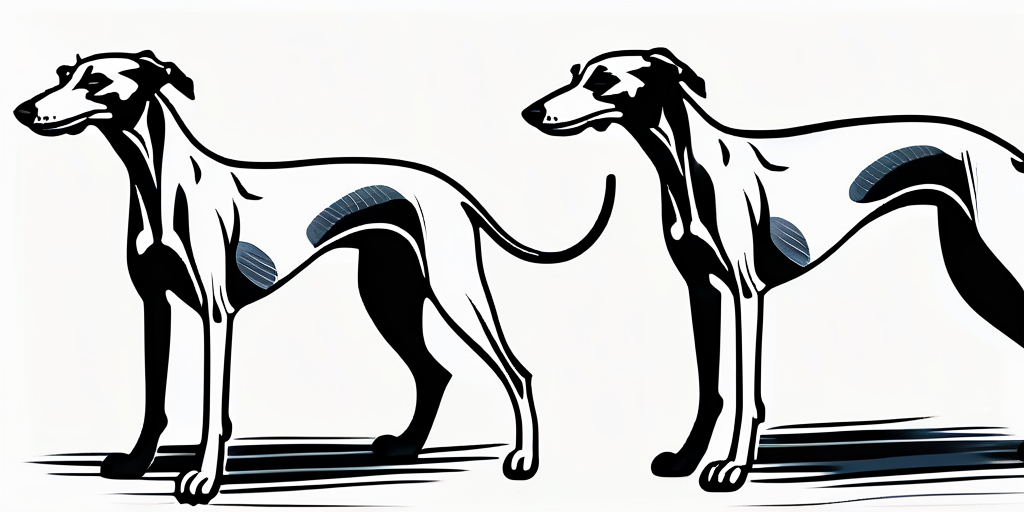The Italian Greyhound and the Greyhound are two distinct breeds of dogs that share certain similarities but also have notable differences. In this article, we will explore their origin, physical characteristics, temperament, health, and care requirements. By understanding these key differences, potential dog owners can make an informed decision about which breed is best suited to their lifestyle and preferences.
Understanding the Breeds: Italian Greyhound and Greyhound
The Italian Greyhound and the Greyhound both belong to the sighthound family, which means they are bred for their remarkable speed and agility. However, they differ in various aspects, including their origin, history, and purpose. Let’s delve into these factors to get a better understanding of each breed:
Origin and History of Italian Greyhounds
The Italian Greyhound, as the name suggests, originally hails from Italy. This elegant and diminutive breed has a rich history dating back to ancient Egypt, where artistic depictions of similar dogs can be found. Italian Greyhounds were highly favored among nobility during the Renaissance period and were often kept as companion dogs.
Italian Greyhounds are known for their affectionate and gentle nature, making them excellent family pets. Despite their small size, they are agile and have a strong prey drive, inherited from their sighthound lineage. This breed thrives on human companionship and is happiest when by their owner’s side, whether relaxing on the couch or going for a brisk walk in the park.
Origin and History of Greyhounds
The Greyhound, on the other hand, has a more ancient lineage and is believed to have originated in Egypt or the Middle East several thousand years ago. These dogs were prized for their exceptional hunting skills, particularly in chasing down game animals. Greyhounds were regarded as symbols of aristocracy and were often associated with royalty and nobility throughout history.
Greyhounds are renowned for their incredible speed, capable of reaching up to 45 miles per hour in just a few strides. This speed and agility made them valuable assets for hunting, as they could quickly chase down prey with precision and grace. Despite their athletic prowess, Greyhounds are gentle and affectionate companions, known for their calm demeanor and love for lounging on comfortable beds for hours on end.
Physical Characteristics: A Comparative Analysis
While both breeds are renowned for their slim and athletic build, there are notable differences in their physical characteristics that distinguish them from one another. Let’s compare these differences:
Italian Greyhounds and Greyhounds are both elegant breeds known for their slender physique and graceful movements. However, beyond their shared athleticism, there are distinct variations that set them apart.
Size and Weight Differences
The Italian Greyhound is a smaller breed, typically weighing between 6 and 15 pounds (2.7 to 6.8 kilograms) and standing around 13 to 15 inches (33 to 38 centimeters) tall at the shoulder. In contrast, the Greyhound is larger, weighing between 60 and 70 pounds (27 to 32 kilograms) and measuring 27 to 30 inches (68 to 76 centimeters) tall at the shoulder. This substantial difference in size is evident when comparing the two breeds side by side.
Despite their size difference, both breeds share a common ancestry and history as sighthounds, bred for their speed and agility in hunting.
Coat and Color Variations
When it comes to the coat, both the Italian Greyhound and the Greyhound have short and smooth hair. However, the Italian Greyhound’s coat is typically thinner and finer compared to the denser and coarser coat of the Greyhound. In terms of color, both breeds exhibit a wide range, including various shades of brindle, fawn, black, blue, and white.
The sleek coat of the Greyhound serves as protection against the elements, while the Italian Greyhound’s finer coat is more suited to its indoor lifestyle as a beloved companion.
Temperament and Personality Traits
The temperament and personality traits of a dog greatly influence its compatibility with potential owners. Here, we explore the distinct characteristics of the Italian Greyhound and Greyhound:

Italian Greyhound Temperament
The Italian Greyhound is known for its affectionate and sensitive nature. They are often described as gentle, loving, and highly attached to their human companions. This breed thrives on attention and prefers to be surrounded by familiar faces. Italian Greyhounds can be prone to separation anxiety if left alone for extended periods, making them best suited for families or individuals who can provide them with constant companionship.
Italian Greyhounds are also known for their playful and mischievous side. Despite their elegant appearance, they have a goofy and fun-loving personality that endears them to many. This breed is quite intelligent and can excel in various dog sports and activities, keeping both their minds and bodies engaged. Due to their slender build, Italian Greyhounds are sensitive to cold weather and may require extra protection during chilly seasons.
Greyhound Temperament
The Greyhound, despite its size, is known for its gentle and calm demeanor. They are typically laid-back, reserved, and somewhat independent. Greyhounds are exquisite and loyal pets, but they are not as demanding of attention as the Italian Greyhounds. Due to their history as racing dogs, Greyhounds may retain a strong prey drive, making them less suitable for homes with small pets.
Greyhounds have a remarkable ability to sprint at high speeds, often reaching up to 45 miles per hour. Despite this athleticism, they are content to lounge around the house for most of the day, earning them the nickname “couch potatoes.” While they may appear aloof at first, Greyhounds form deep bonds with their families and can be incredibly affectionate towards their loved ones. It’s important to provide them with regular exercise to maintain their muscle tone and overall well-being.
Health and Lifespan: What to Expect
Understanding the common health issues and average lifespan of a breed is crucial for responsible dog ownership. Let’s take a closer look at the health considerations for both the Italian Greyhound and the Greyhound:
When it comes to the Italian Greyhound, this elegant and slender breed is generally known for its good health. However, like all breeds, they are predisposed to certain conditions that potential owners should be aware of. Italian Greyhounds are prone to dental problems, such as tartar buildup and gum disease, which can be managed through regular dental care and professional cleanings. Additionally, patellar luxation, a condition where the kneecap dislocates from its normal position, is relatively common in Italian Greyhounds. Regular exercise and maintaining a healthy weight can help support the joints and reduce the risk of this condition.
Common Health Issues in Italian Greyhounds
Italian Greyhounds are generally a healthy breed, but they have a predisposition to certain conditions. These include dental problems, patellar luxation (a condition affecting the kneecap), progressive retinal atrophy (a degenerative eye disease), and certain hereditary skin disorders. Regular dental care, annual eye exams, and maintaining a healthy weight can help mitigate these health concerns.
Moreover, Italian Greyhounds are known to be susceptible to progressive retinal atrophy (PRA), a genetic eye disorder that can lead to vision impairment and eventual blindness. Routine eye exams by a veterinary ophthalmologist can help detect this condition early on, allowing for appropriate management strategies to be implemented. Additionally, some Italian Greyhounds may inherit certain skin disorders, such as allergies or sensitivities, which may manifest as itching, redness, or hair loss. Working closely with a veterinarian to identify and address any skin issues is crucial for maintaining the overall well-being of these sensitive dogs.
Common Health Issues in Greyhounds
Greyhounds are also relatively healthy, but they are prone to specific conditions. These may include bloat (gastric torsion), osteosarcoma (a type of bone cancer), hypothyroidism, and certain cardiac issues. Regular exercise, proper nutrition, and routine vet check-ups are essential for maintaining the overall health of a Greyhound.
On the other hand, Greyhounds, known for their incredible speed and graceful demeanor, are generally a robust and healthy breed. However, prospective owners should be aware of certain health issues that can affect these athletic dogs. Greyhounds are at an increased risk of bloat, a life-threatening condition where the stomach twists on itself, cutting off blood flow. Feeding multiple small meals throughout the day, rather than one large meal, and avoiding vigorous exercise after eating can help reduce the likelihood of bloat in Greyhounds. Additionally, osteosarcoma, a type of bone cancer, is more prevalent in Greyhounds than in some other breeds. Early detection through regular veterinary screenings and monitoring for signs of lameness or swelling can improve the prognosis for dogs affected by this aggressive cancer.
Care and Maintenance: What They Need
Providing adequate care and meeting the maintenance needs of a dog are essential responsibilities of an owner. Let’s explore the specific requirements for both the Italian Greyhound and the Greyhound:

Exercise and Activity Levels
Both breeds have similar exercise needs, requiring regular physical activity to keep them healthy and happy. Daily walks, play sessions, and mental stimulation are essential for preventing boredom or destructive behaviors. It’s important to note that Greyhounds tend to have bursts of energy followed by long periods of lounging, while Italian Greyhounds benefit from short bursts of exercise throughout the day.
Feeding and Nutrition Requirements
The dietary needs of dogs vary depending on factors such as age, size, and activity level. It is vital to provide a well-balanced diet that meets the nutritional requirements of each breed. Feeding schedules and portion control should be discussed with a veterinarian to ensure optimal health and weight management for both the Italian Greyhound and the Greyhound.
When it comes to grooming, both the Italian Greyhound and the Greyhound have short coats that are relatively low maintenance. Regular brushing to remove loose hair and occasional baths to keep their skin and coat healthy are recommended. Additionally, checking their ears for any signs of infection and trimming their nails regularly are important aspects of their grooming routine.
Training and socialization are crucial for both breeds to ensure they become well-behaved and well-adjusted companions. Positive reinforcement methods work best for these sensitive breeds, and early socialization with other dogs and people can help prevent any potential behavioral issues in the future. Both Italian Greyhounds and Greyhounds are intelligent breeds that thrive on mental stimulation, so engaging them in training sessions and interactive games can help keep their minds sharp and active.
Discover More with BreedRead
Ready to dive deeper into the world of Italian Greyhounds, Greyhounds, and other dog breeds? Subscribe to our free newsletter at BreedRead.com, your ultimate online resource for comprehensive breed information. Enhance your knowledge and ensure you’re making the best decisions for your furry friend with our expertly crafted guides, comparisons, and care tips. Join the BreedRead community today and start your journey towards a happier, healthier life with your beloved canine companion.

